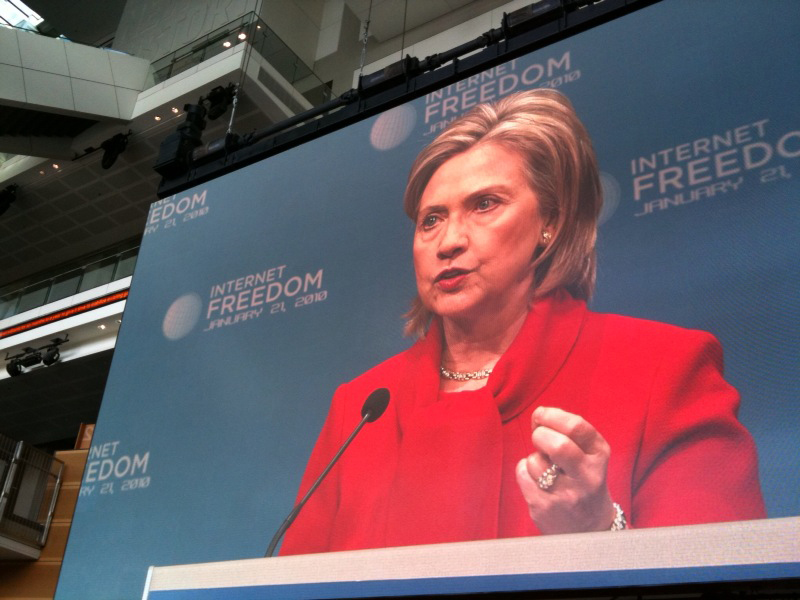Internet Freedom 10 Years In
Hillary Clinton gave her first speech on internet freedom 10 years ago today. How does it read after a decade of increasing skepticism about whether the internet is good for the world?

Published by The Lawfare Institute
in Cooperation With

Hillary Clinton gave her first speech on internet freedom 10 years ago today. When I started my job at Facebook nearly a year later, in January 2011, you could still feel its reverberations.
Egypt shut off the internet during my first week in the job, and one of my first assignments was to help draft our comment for the press. Egypt was waging a new type of war against a new type of communication technology. Clinton’s speech established a foundation for our response. Internet freedom, she said, is “about whether we live on a planet with one internet, one global community, and a common body of knowledge that benefits and unites us all, or a fragmented planet in which access to information and opportunity is dependent on where you live and the whims of censors.” An open internet was a better internet, both in Clinton’s eyes and in Facebook’s. My colleagues and I would try to make that vision a reality.
With the anniversary of Secretary Clinton’s speech approaching, I looked back at it, curious to see how it reads after a decade of increasing skepticism about whether the internet is good for the world.
Critics have often pointed to the secretary’s speech as reflecting a naive and excessively rosy view of the internet’s impact on the world. But in looking back at the speech, I was surprised to find that Clinton’s view of technology is hardly a sunny one.
Sure, she talked about the potential value for people throughout the world of expanded internet access. As the internet’s reach expands, for example, people were developing new forms of banking in Africa, and people were using new communication technologies to organize protests against fraudulent elections. And, yes, she passionately advocated for an open internet, cautioning against the Chinese model and a world of fractured, nationalized internets.
But she was clear that the internet also had dark sides. “Amid this unprecedented surge in connectivity,” she said, “we must also recognize that these technologies are not an unmitigated blessing.” She warned about threats to privacy and the pitfalls of open expression, and she anticipated the kinds of security breaches that have threatened our electoral system. She also recognized the role that companies play in both expanding and undermining human rights, and called on them to be better stewards of international human rights principles.
The two faces of internet freedom—freedom that creates new opportunities and freedom that creates new risks—were mirrored by U.S. policy at the time. As Clinton decried the privacy practices of other governments, the U.S. government was using its national security authorities to gather a large amount of user data.
Ten years later, Clinton’s ambivalence about the internet’s impact seems prescient. Despite long-running debates about whether the internet is good or bad, the past 10 years have given us a lot of evidence that it’s both. People are wonderful and awful, rational and crazy, incredibly kind and shockingly cruel. The result is that we have an internet that mirrors the goodness and the frailty of humanity.
But when we think of internet freedom today, it’s the darkness that we see. Privacy breaches. Security vulnerabilities. Safety threats to children and people of color. Disinformation and election interference. Information silos that corrode our sense of shared values and community.
As a result, the main policy ingredients of Clinton’s internet freedom agenda—maximizing expression, minimizing censorship, ensuring limited intermediary liability and protecting against government surveillance—have come under attack. To some observers, the internet has become a global epidemic, and the internet freedom policy agenda is the regulatory patient zero of the disease.
That assessment has put policy options that once seemed absurd at the forefront of the policy conversation. It used to seem obvious, for example, that we didn’t want Google to be regulated like a utility company. Did we really want our Gmail to function like our gas or electricity service? But now, it’s common to hear people argue that tech companies should be regulated like utilities.
It’s also increasingly common for people to view other regulatory models as more desirable than the American one. The Chinese model—deep investment in innovation, coupled with extensive censorship and surveillance—was once widely vilified in the rest of the world but is now regarded with envy by some Western analysts who believe the Chinese system showcases the successful balance of state control, economic growth and innovation. And, on privacy, Europe is regarded as the global leader in the wake of its implementation of the General Data Protection Regulation (GDPR), which expands privacy rights for users, despite the adverse effect the regulation has had on tech investment.
There are many ways to evaluate the legacy of the internet freedom agenda. To some, the best way to measure success is to look at the world Clinton envisioned and to compare it to the world we have. Looked at in this light, the internet freedom project has not succeeded.
Despite her acknowledgment of the internet’s darker side, Clinton envisioned that the arc of the internet would bend toward openness. But that’s not the path we’re on. The regulatory models now being adopted in regions such as Europe and Asia have tended to be more closed than the open internet Clinton envisioned, often with fewer speech protections, more robust surveillance authority and more hurdles for innovation. And, despite the relatively small number of regulatory reforms in the United States to date, many policymakers in Washington and in state capitals are pushing for regulations that would walk away from the core principles of the internet freedom agenda.
Whether or not a speech accurately forecasts the future isn’t the only way to measure its quality. The best policy speeches give us something to aspire to, articulating a vision for what we might achieve if we are the best version of ourselves.
From that perspective, the speech outlined an aspirational policy framework that was helpful in 2010 and that continues to be helpful today. We strive to promote expression but avoid harm. We seek to provide safety but not safe harbors for illegality. We want to preserve spaces for privacy but not create unnecessary barriers to innovation. “We need to synchronize our technological progress with our principles,” she said. Regardless of whether that’s useful as a prescriptive policy agenda, it’s vital as an aspirational one.
What does that mean in practice? Congress is considering more and more proposals to regulate technology. With the presidential campaign heating up, pundits are beginning to speculate about what the technology policy agenda will be for the administration that’s inaugurated in January 2021. As we consider new policy agendas, we’ll need to determine whether we should deviate from the policy framework that’s been the foundation of innovation in the United States to date. Clinton’s speech points to the right question—How do we balance our aspirations for what technology might be against our concerns about its reality? But it doesn’t give us the answer.
To get closer to the answer, we need to choose the right analytical tools. Cost-benefit analysis, for instance, provides a framework for quantifying Clinton’s rhetoric of aspiration and ambivalence. By assigning value to both the opportunities and the risks of specific policy proposals, it enables us to evaluate which policy solutions are most likely to produce more good than harm.
Cost-benefit analysis is a useful tool because it imposes rigor on our policy analysis, requiring us to wrestle with both the opportunities and the risks of internet freedom, as well as the opportunities and the risks of the policy reforms that would chart a new course. By requiring analytical discipline on all sides of the ledger, it forces us to confront the fact that many of the proposed policy solutions also have their own dark sides. Breaking up large tech companies might seem compelling as a way of constraining corporate power, but would the internet be safer and more secure if companies’ security teams were split up and downsized? Restricting political advertising could limit exposure to false ads, but how many other voices will it silence?
Even as we’ve become almost obsessively focused on the internet’s dark sides, the opportunities Clinton spoke of remain. In considering reforms to the internet freedom agenda, we should be wary of proposals that would severely curtail those opportunities without providing commensurate gains. It’s easy to say that we need to reform the technology sector, but it’s much harder to develop and enact the reforms that will make our technologies better.
If there’s one takeaway from Clinton’s speech 10 years ago, it’s that we should try. “We recognize that the world’s information infrastructure will become what we and others make of it,” she said, urging us to be guided by the better angels of our tech nature. For those of us working in tech policy, that’s something worth aspiring to.





